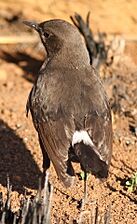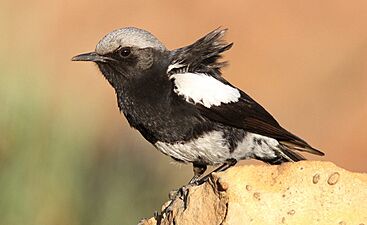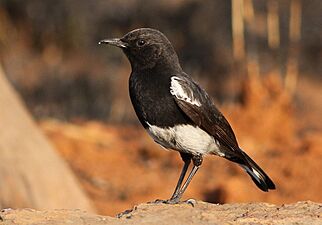Mountain wheatear facts for kids
Quick facts for kids Mountain wheatear |
|
|---|---|
 |
|
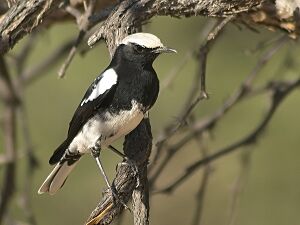 |
|
| Males of the nominate (top) and westerly race, O. m. atmorii (bottom) | |
| Conservation status | |
| Scientific classification | |
| Genus: |
Myrmecocichla
|
| Species: |
monticola
|
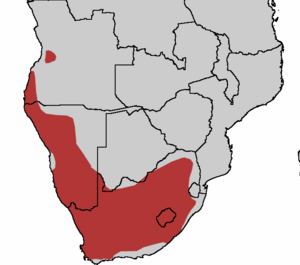 |
|
| resident range | |
| Synonyms | |
|
Oenanthe monticola Viellot, 1918 |
|
The mountain wheatear (also known as the mountain chat) is a small, insect-eating bird. It is special because it lives only in southwestern Africa.
Contents
Where Does the Mountain Wheatear Live?
This amazing bird does not migrate, meaning it stays in the same place all year. You can find mountain wheatears living in rocky, mountainous areas. They make their homes in countries like Namibia, Botswana, South Africa, and the very southern part of Angola.
What Does the Mountain Wheatear Look Like?
The mountain wheatear is about 18 to 20 centimeters (7 to 8 inches) long. Like other wheatears, it has a special tail pattern. Its lower back and the outer feathers of its tail are white. Its legs and pointed beak are black.
The male mountain wheatear can look quite different from one bird to another. However, they always have that unique tail pattern and a white patch on their shoulder. Their body feathers can be light grey or almost black. Some males even have a white top of the head, while others have a darker one.
The female mountain wheatear is mostly dark brown. The only white parts on her are her lower back and the outer tail feathers, just like the male.
Habits and Life
The mountain wheatear has a beautiful song. It's a clear, musical whistle that sometimes has harsh chattering sounds mixed in.
These birds are monogamous, which means a male and female pair up to raise their young. They build their nests on the ground, often hidden among rocks. The female usually lays 2 to 4 white eggs.
What do they eat? Mountain wheatears love to snack on insects. They also eat berries sometimes.
How Scientists Classify This Bird
For a long time, scientists thought the mountain wheatear belonged to the thrush family. But after new studies in 2004 and 2010, they found it was actually part of the Old World flycatcher family.
This bird was once placed in a group called Oenanthe. However, more studies in 2010 and 2012 looked at the bird's DNA. They discovered that the mountain wheatear was not closely related to other birds in the Oenanthe group. Instead, it was more like the chats in the group called Myrmecocichla. Because of this, the mountain wheatear was moved to the Myrmecocichla genus.
Images for kids



